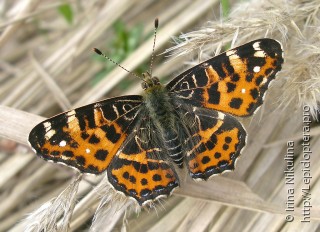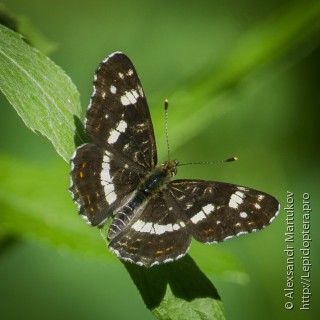Araschnia levana
Taxonomy
class Insecta
Species name(s)
Araschnia levana (Linnaeus, 1758) = Papilio levana Linnaeus, 1758 = Araschina levana = Araschnia caerulocellata Lempke 1956 = Araschnia clossi Krombach 1916 = Araschnia dammeri Fischer 1932 = Araschnia gerardini Oberthür 1925 = Araschnia intermedia Stichel 1908 = Araschnia kudlai Adámek 1942 = Araschnia lactofasciata Lempke 1956 = Araschnia marginelineata Horch 1932 = Araschnia porima Ochsenheimer 1807 = Araschnia prorsa Linnaeus 1767 = Araschnia postcontinua Lempke 1956 = Araschnia pseudorientalis Reuss 1939 = Araschnia postocellata Lempke 1956 = Araschnia schultzi Pfitzner 1906 = Araschnia rufescens Lempke 1956 = Araschnia ypsilon Krombach 1916 = Araschnia zavreli Rúzik 1939 = Araschnia weismanni Fischer 1902. [9, 10, 187]
Map Butterfly.
urn:lsid:insecta.pro:taxonomy:8612
Expansion
This species marks on the maps: 9.
Zoogeographical regions
Palaearctic.
Russia regions
#1. Kaliningradsky; #3. Karelsky; #4. Evropeisky Severo-Zapadny; #6. Evropeisky Severo-Vostochny; #7. Evropeisky yuzhno-tayozhny; #8. Evropeisky Tsentralny; #9. Evropeisky Tsentralno-Chernozyomny; #10. Sredne-Volzhsky; #11. Volgo-Donsky; #13. Zapadno-Kavkazsky; #15. Severo-Uralsky; #16. Sredne-Uralsky; #17. Yuzhno-Uralsky; #18. Nizhneobsky; #19. Sredneobsky; #20. Yuzhno-Zapadnosibirsky; #21. Severo-Yeniseisky; #22. Krasnoyarsky; #23. Predaltaisky; #24. Gorno-Altaisky; #25. Tuvinsky; #26. Predbaikalsky; #27. Pribaikalsky; #28. Zabaikalsky; #31. Yuzhno-Yakutsky; #33. Severo-Okhotomorsky; #35. Sredne-Okhotsky; #36. Sredne-Amursky; #37. Nizhne-Amursky; #40. Primorsky.
Forewing length
18—20 mm.
Primary colors
Orange, Brown/Gray/Black, White.
Flight time
| January | February | March | April | May | June | July | August | September | October | November | December |
Larva lifespan
| January | February | March | April | May | June | July | August | September | October | November | December |
Detailed information with references
Distribution
Imago Habitus and Differences from alike species
General info about Imago
Imago lifespan
General info about Larva
Larva food plants / other food objects
Larva lifespan
Egg
Overwintering stage
Subspecies of Araschnia levana
- Araschnia levana borgesti Kardakoff, 1928. [187]
- A. l. levana. [9]
- A. l. sachalinensis Shriôzu, 1952. [9]
- A. l. separata Kardakoff, 1928. [187]
- A. l. wladimiri Kardakov, 1928. [9]
Authors
Initial species uploading to the site: Peter Khramov.
Text data: Peter Khramov.
The species characteristics formalization: Peter Khramov.
References
- [1] O. Karsholt, J. Razowski (eds.), 1996. The Lepidoptera of Europe: a distributional checklist
- [3] Каталог чешуекрылых (Lepidoptera) России. Под ред. С. Ю. Синёва. СПб.; М.: Товарищество научных изданий КМК, 2008
- [9] Tree of Life (funet.fi), 2012
- [10] de Jong, Y.S.D.M. (ed.) (2011) Fauna Europaea version 2.4 (faunaeur.org)
- [28] Moths and Butterflies of Europe and North Africa (leps.it), 2012
- [85] Lepidoptera species catalogue, Lepidoptera.ru, 2015
- [187] Species 2000, http://www.sp2000.org
Comments
Note: you should have a Insecta.pro account to upload new topics and comments. Please, create an account or log in to add comments
Araschnia levana photos

















































































































All the photos of the species in large size
Please, create an account or log in to upload your photo




